Anyone that has ever gone watch-shopping has come across a Seiko. It’s one of the most popular watch brands in the world. But do they actually make good watches?
Seiko is, without a doubt, a good watch brand. It’s one of the most respected watchmakers, known for its high-quality and relatively affordable watches. All are made with care and precision.
It’s safe to say that Seiko is a top-tier brand, especially considering its low price points. Read on to learn why Seiko is such a good brand and how they compare to other well-known names.
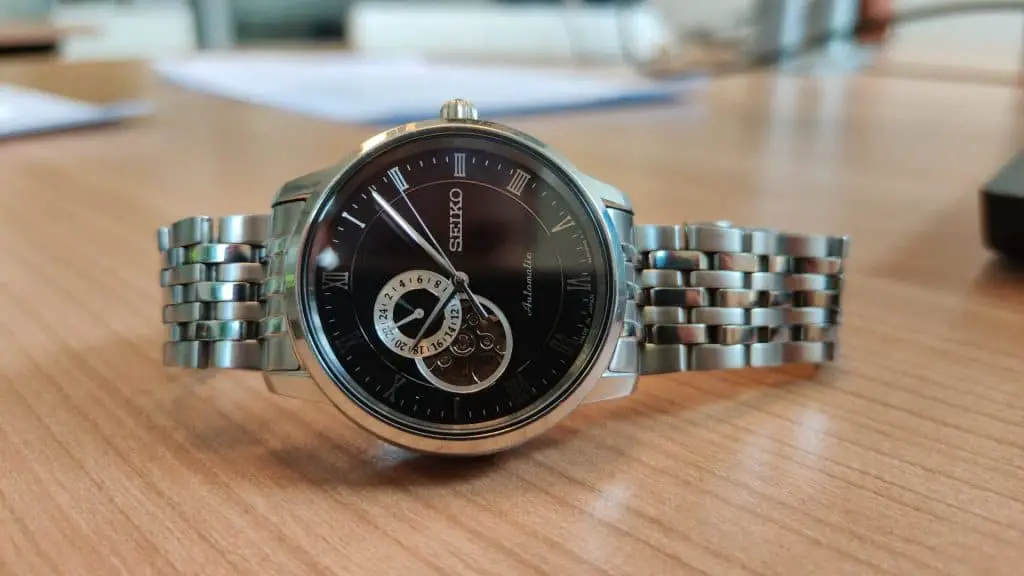
Table of Contents
Does Seiko Make Good Watches?
Whether or not a brand makes good watches depends on many factors.
Below, we’ll dive into the most important ones and discuss them in depth.
Manufacturing
When it comes to quality, perhaps the most important part is how everything’s assembled.
Your watch could be made with the most fantastic materials available to mankind, but if it’s poorly slapped together, it will still not be that good.
Luckily, this is a part where Seiko excels.
See, Seiko is one of the few watch brands that is entirely vertically integrated.
This is a complex way of saying that Seiko literally makes everything in-house. From the springs to the dials to the movement.
Everything used to make a Seiko watch is made and assembled in-house.
What this allows them to do is keep quality control extremely high. They can literally check and assess every part of the watch.
Any broken or faulty pieces can also be directly traced back, allowing them to make any necessary adjustments immediately.
And they also don’t have to deal with faulty or late suppliers. It’s all coming from Seiko itself.
With such a vertically integrated process, Seiko can experiment more than other watch brands can.
For example, they were the first to use titanium for the watch case. And they constantly innovate their movements.
Speaking of the manufacturing process, Seiko watches are made in either Japan, Malaysia, Singapore, or China.
Higher-end models tend to be made in Japan, while most of the more affordable models are made in cheaper countries.
However, this does not mean they are of lesser quality.
All Seiko factories in these countries are owned by Seiko and have to abide by Seiko’s strict quality guidelines.
Movement
The movement is one of, if not the most essential part of the watch. It’s what keeps the watch moving and is often referred to as the heart of a watch.
Naturally, this is an essential part.
But producing your own movement is extremely difficult and expensive.
Most affordable brands opt to simply source their movement from third parties.
But as we touched on earlier, Seiko makes everything in-house. Including the movement.
Typically, a Seiko movement is produced in one of the cheaper countries. The brand owns subsidiaries in Malaysia, China, and Singapore, and wages are considerably lower here.
But since these subsidiaries are 100% owned by Seiko, the movement is made in-house. And once again, everything meets the strict quality guidelines.
And that’s something not many brands can say.
Typically, only luxury watch brands tend to have an in-house movement.
But so does Seiko.
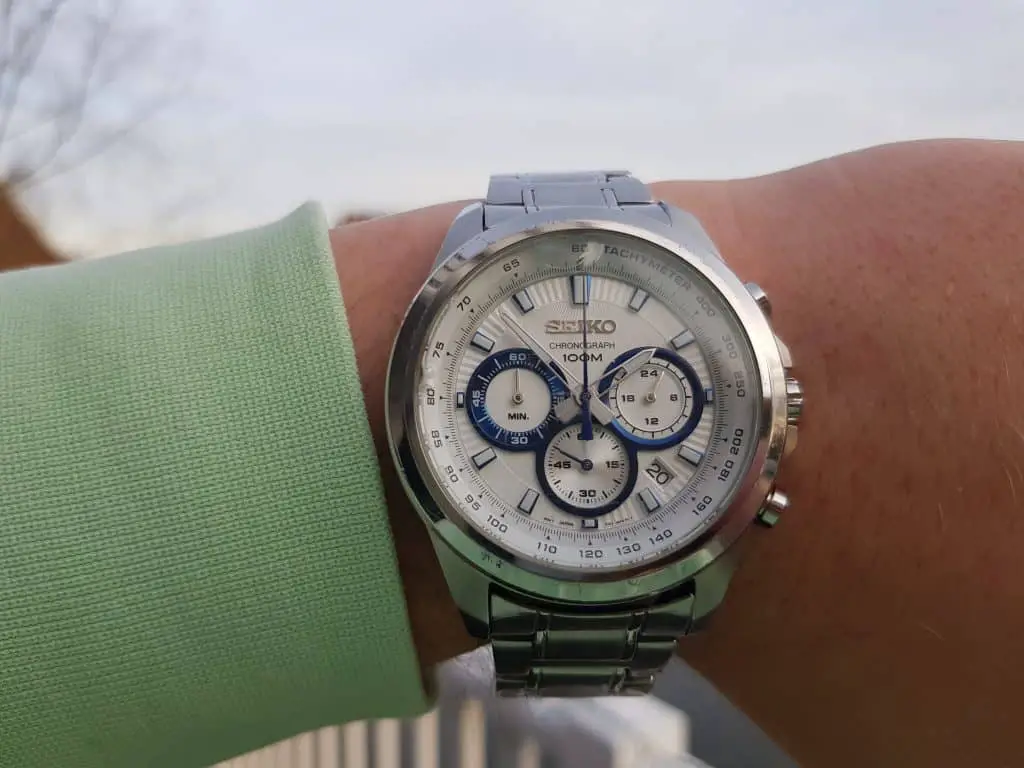
And to take it a step further, Seiko is pretty revolutionary with its movements.
Take the Spring Drive technology, for example. This was a ground-breaking movement featured in Grand Seiko timepieces.
As for most Seiko’s, though, you’ll find a simple quartz movement.
These movements are relatively affordable, require very little maintenance, and are highly reliable.
All in all, Seiko has always been known for its reliable and accurate movements.
Materials
Aside from the great movement and the solid manufacturing process, a Seiko is also made with top-tier materials.
In this section, we’ll take a look at the case, strap, and crystal.
The Seiko Case
The case is the most prominent part of a watch. It’s what houses the dial, and it’s what everyone sees first.
While Seiko tends to keep its prices on the more affordable side, it doesn’t mean that they don’t use high-quality materials.
For the watch case, Seiko uses either:
- High-quality stainless steel.
- 18K gold.
- Titanium.
While gold and titanium are sometimes used, these are typically found only in the higher-end models.
For example, 18K gold is only found in a Grand Seiko, the brand’s luxury segment.
However, Seiko does offer gold-plated watches. These aren’t made with actual gold but, instead, have a minuscule layer of a golden mixture plated onto the stainless steel.
And Seiko models with titanium tend to cost $2.500 or more, such as the Seiko Astron SSH067.
So that leaves stainless steel as the material of choice for most Seiko timepieces.
For this, Seiko uses the 316L stainless steel alloy.
This is the industry standard for watchmaking, picked over the 304 alloy that’s more widely used for general use in our world.
The 316L alloy is basically the 304 alloy; only molybdenum is added to the mix. This is a silver/white metal that increases the alloy’s resistance to corrosion.
In addition, it also makes the stainless steel more heat resistant, which is especially important during the manufacturing process.
The Seiko Strap
The strap of a watch tends to follow one of either route:
- The strap is the same material as the case.
- The strap is made with a different material.
In the first case, the strap will be made out of the very same materials as the case.
Since Seiko typically uses 316L stainless steel for their cases, the strap will also be made out of that.
And, of course, it follows the same quality standards.
However, it isn’t uncommon for a strap to be made of a different material.
Seiko offers the following strap materials:
- Silicone.
- Nylon.
- Fabric.
- Leather.
- Crocodile leather.
- Metal.
Seiko bands are typically nothing too special. That said, the quality is definitely up to Seiko’s standards, so there’s nothing wrong there.
Naturally, timepieces with a crocodile leather strap are priced higher.
But in general, all materials pass the quality standards.
The Seiko Crystal
The crystal is the piece of ‘glass’ that covers the watch’s face.
For this, there are once again a couple of options:
- Acrylic glass.
- Mineral glass.
- A sapphire crystal.
These are ordered from worst to best.
Acrylic glass is basically a cheap piece of plastic that covers the face and is by far the worst material out there.
With that in mind, it’s good to know that not a single Seiko watch will have acrylic glass covering the face.
Instead, Seiko always goes for mineral glass.
Although mineral glass can get scratched over time, it is a very sturdy and reliable material.
The best option is a sapphire crystal. This material is so scratch-resistant that it can only be scratched by diamonds.
However, a sapphire crystal is reserved for high-end timepieces such as Grand Seiko’s.
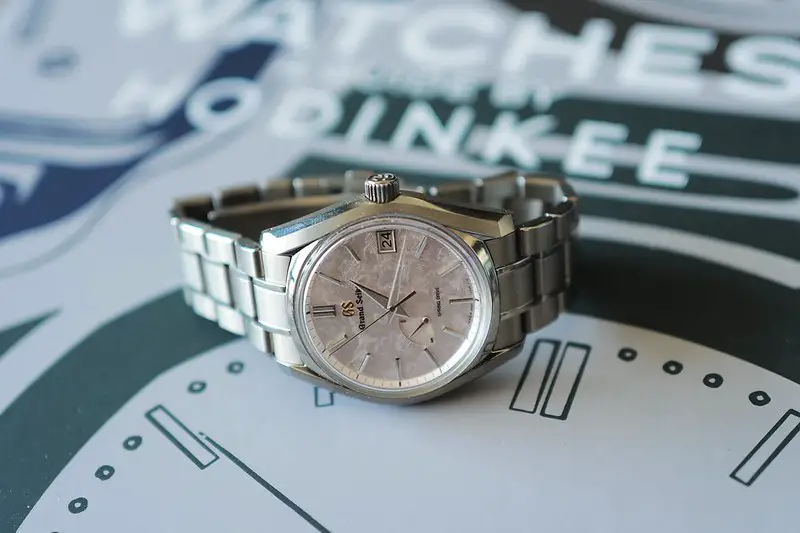
Accuracy
Another show of Seiko’s high quality is the accuracy of their watches.
In case you don’t know, every watch will deviate ever so slightly. No watch created will ever be 100% accurate to the last second.
And that’s the same for Seiko.
All of their watches will be inaccurate to some degree. And the movement of that particular watch will determine how much.
See, there are 3 different types of movements:
- Quartz.
- Automatic.
- Mechanical.
An automatic and a mechanical movement are relatively similar in the sense that they need to be wound.
A quartz movement, on the other hand, functions on a battery.
While a mechanical or automatic movement is typically found in high-end timepieces, the quartz movement is the most accurate.
Earlier, we mentioned how Seiko makes its movements in-house, and Seiko produces all 3 movement types.
And they also provide an estimate of how accurate their movements are:
| Seiko Movement Type | Expected Deviation |
|---|---|
| Seiko Automatic | +/- 25 seconds/day |
| Seiko Mechanical | +/- 25 seconds/day |
| Seiko Quartz | +/- 10 seconds/year |
Both automatic and mechanical Seiko watches tend to have a daily deviation of 25 seconds.
And since Seiko is at the forefront of quartz technology, their quartz watches have a deviation of only 10 seconds per year.
However, it has come to show that Seiko is very conservative with these numbers.
In reality, both Seiko’s mechanical and automatic movements tend to deviate only 6 seconds a day.
That totals to a maximum deviation of 42 seconds a week, keeping you within the minute mark.
Were you never to adjust the time; your watch will deviate 36 minutes after a year of wear. This is pretty great for a mechanical or automatic watch!
Position In The Market
When you want to be a successful brand, its public image of it has to be good.
You could make the best products possible, but if everyone thinks what you make sucks, you’ll lag behind.
Seiko is often seen as one of the more respected watch brands. They don’t quite sit amongst the likes of Audemars Piguet or Rolex, but they’re seen as one of the best brands that offer affordable timepieces.
And that’s exactly what Seiko is.
A great and reliable brand that offers watches that don’t break the bank.
In terms of direct competition, there really are only a few brands with such a good reputation and high-quality products.
Citizen and Hamilton come to mind. And maybe also Tissot.
Currently, Seiko offers several different models under the Seiko name and several more under the Grand Seiko name.
The current Seiko models are:
- Seiko Prospex
- Seiko Presage
- Seiko Astron
- Seiko 5
- King Seiko
Along with these models, Seiko also incorporates cool design features such as Seiko Kinetic, GPS, and Solar.
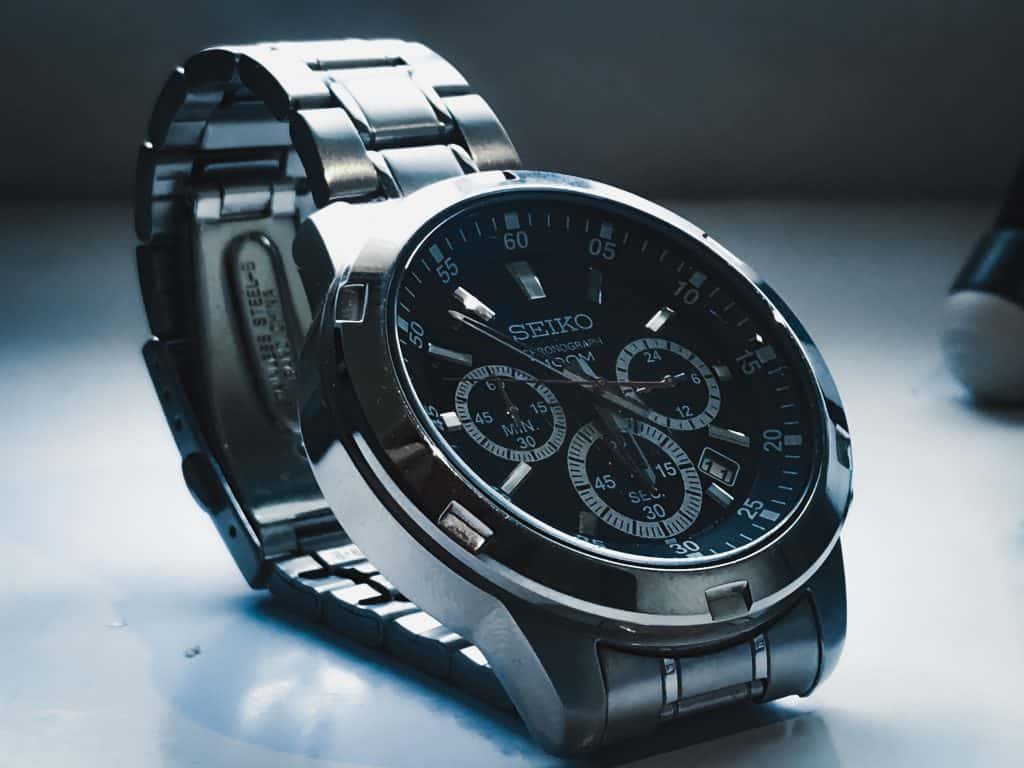
Is Seiko A High-End Watch Brand?
Seiko is one of the more respected watch brands in the world.
But it isn’t quite a luxury watch brand.
See, for a brand to become a luxury watch brand, it needs to meet some guidelines.
And Seiko simply doesn’t meet all of them.
The guidelines in question are;
- The brand must have an in-house movement.
- The brand must incorporate luxurious materials.
- The watches have to be hand-assembled.
- The watches must be exclusive.
We’ve established that Seiko does produce an in-house movement. But that’s just about it for the brand.
While they use high-quality materials, they tend not to use luxurious materials.
A few examples of luxurious materials are gold, platinum, and diamonds. However, Seiko watches are typically made with just stainless steel.
On top of that, Seiko also mass-produces its timepieces.
There’s nothing inherently wrong with that, but from luxury brands, it’s expected that the watches are hand-assembled.
But most importantly, a Seiko watch just isn’t all that exclusive.
They’re generally very affordable, and they’re widely available.
Just walk into any watch shop, and chances are that Seiko’s are present.
Since pretty much everyone can buy one, they’re not that exclusive.
And that really takes away from the ‘luxury’ feeling. Just imagine if anyone was able to purchase a Rolex. Would they really still be all that special?
Now, all of this does exclude the Grand Seiko brand.
Grand Seiko is typically seen as a standalone brand. And with that, they’re also seen as a luxury brand.
In fact, it is often said that Grand Seiko’s are better than most Rolex watches.
Do Seiko Watches Hold Their Value?
Despite Seiko’s timepieces being of excellent quality, they tend to lose their value over time.
Obviously, it’s a bit more nuanced than that, but generally, these watches don’t hold their value all that well.
And that’s actually true for most watches, believe it or not.
For a watch to hold its value, it has to be exclusive, and it has to be in demand.
It’s the age-old law of supply and demand.
A low supply paired with a high demand equals an increase in value.
And that also works vice versa, which is primarily the case for Seiko.
They have a rather large demand, but the same is true for the supply.
In fact, the supply is often larger than the demand, leading to a decrease in value over time.
For example, I own a Seiko that dates back to 1993. I found that out by tracing back the serial number of the watch.
You’d think an older watch like that would have appreciated in value, right?
Well, that isn’t the case.
In fact, the value has actually gone down slightly. Not by a lot, but you can buy a second-hand version for about 10-20% cheaper than retail.
However, there are some Seiko watches that do hold their value.
The biggest driver for a watch to hold its value is its exclusivity. So the few Seiko’s that do hold their value tend to be limited editions or otherwise highly sought-after pieces.
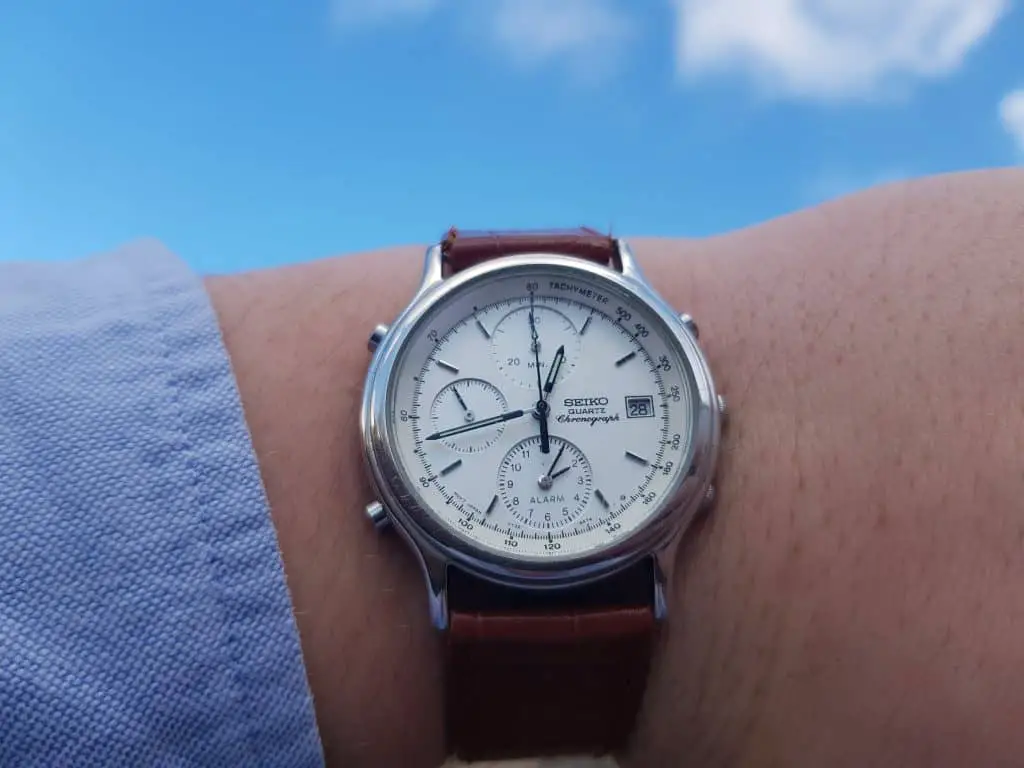
How Long Do Seiko Watches Last?
We’ve established that Seiko produces great-quality watches. But how long these timepieces will last once again depends on a few factors.
Seiko Automatics and Mechanicals
Despite being slightly less accurate than quartz timepieces, an automatic or mechanical watch is far more resilient.
These movements are designed to last a lifetime.
Since the watch powers itself by the movement of the wearer’s wrist, there’s no need for a battery swap or anything of the sort.
You simply need to wear the watch, maybe set the time correctly again, and you’re good to go.
However, having your watch serviced every now and then is recommended.
On average, it’s a good idea to service your Seiko watch every 5 to 7 years.
With a service, your watch is disassembled. After that, all individual parts are inspected, cleaned, and replaced if necessary.
In other words, they make sure your watch functions as new.
Seiko Quartz
Seiko quartz watches are also capable of lasting a lifetime.
However, since these timepieces run on a battery, they will eventually stop working.
Typically, a Seiko watch battery lasts between 3 and 5 years.
It’s easy to spot when the battery has actually died out, as the hands will no longer be moving.
When your battery dies out, it’s essential to have it removed as soon as possible.
Dead batteries tend to leak if they’re left out for a while. And the last thing you want to happen is to have your battery leak inside your watch.
Now, from here, you can either choose to replace the battery or just remove the old one.
A battery replacement typically doesn’t cost more than $20-$30, but it does depend on the model.
Personally, I paid $20 for a new battery. And that included removing the old one and replacing it with the new one.
The Materials
Now, we’ve already gone over the materials used to make a Seiko watch.
In short, all these materials are of excellent quality.
From stainless steel to leather straps, Seiko uses and produces great-quality materials and products.
Speaking purely from a materialistic standpoint, a Seiko watch will last as long as you take proper care of it.
Of course, stainless steel will scratch over time. But it’s a sturdy material that simply won’t wear down easily. And the same goes for all the other materials.
It’s a different story if you keep dropping your watch or constantly bump it against hard surfaces. But for plain everyday wear, any Seiko will last you a lifetime.
Are Seiko Watches Good Value For Your Money?
A Seiko watch is excellent value for your money.
Even most watch enthusiasts would agree that buying a Seiko is one of the best watch purchases you can make.
Not only are they of superb quality, but they’re also very affordable.
I personally own 2 Seiko watches, and I spend less than $500 on the 2 of them.
Both are still working great as well. And considering that one of them is nearly 30 years old, I’d say that’s quite a feat.
Overall, Seiko is one of the few actual watchmakers that offers affordable timepieces.
Most other watch brands that offer such affordable pieces tend to be fashion watch brands.
Brands like these never really focus on making a horological standout. Rather, they just focus on creating a good-looking watch that will sell well.
Seiko also focuses on making great-looking timepieces. But they also ensure they’re of the best possible quality.
All in all, it’s easy to see why this is such a respected brand.
